Choosing the right collar and leash for your small dog is about more than just fashion. It’s a crucial aspect of their safety, comfort, and overall well-being. With so many options available in the US market, finding the perfect fit for your pint-sized companion can feel overwhelming. This comprehensive guide will help you navigate the world of collars and leashes for small dogs, ensuring you make the best choice for your furry friend.
Choosing the Right Collar for Your Small Dog
Small dogs have delicate necks, so a properly fitted collar is paramount. A collar that’s too tight can restrict breathing and cause discomfort, while a collar that’s too loose can slip off, leading to potential escape. There are several types of collars available, each with its own advantages and disadvantages.
Traditional Collars
Traditional collars, typically made of nylon or leather, are a classic choice. They’re affordable, durable, and come in a wide variety of colors and patterns. However, for small dogs who pull on the leash, a traditional collar can put pressure on their trachea.
Harnesses
Harnesses are a popular alternative to collars, especially for small breeds prone to tracheal collapse. They distribute pressure across the chest and shoulders, reducing strain on the neck. Harnesses come in various styles, including front-clip, back-clip, and step-in. Front-clip harnesses can be particularly helpful for training, as they discourage pulling.
Head Collars
Head collars, also known as halters, work by gently redirecting your dog’s head. They offer excellent control, but some dogs may take time to adjust to them.
 Types of Collars for Small Dogs
Types of Collars for Small Dogs
Finding the Perfect Leash for Your Small Dog
The leash you choose should complement your dog’s collar or harness and provide a secure connection during walks and outings.
Standard Leashes
Standard leashes, typically made of nylon or leather, are a versatile option. They come in different lengths and widths to suit your dog’s size and your walking preferences. A retractable leash, while offering more freedom, can be dangerous for small dogs, as they can easily become tangled or injured if they suddenly dart out.
Training Leashes
Training leashes, often shorter than standard leashes, are useful for obedience training. They provide close control and allow for quick corrections.
Specialty Leashes
Specialty leashes, such as double-dog leashes or hands-free leashes, cater to specific needs. A double-dog leash is ideal if you have two small dogs, while a hands-free leash can be helpful for jogging or running with your canine companion.
Sizing and Fitting Collars and Leashes for Small Dogs
Proper fit is crucial for both collars and leashes. A collar that’s too tight can be uncomfortable and potentially harmful, while a collar that’s too loose can slip off. When fitting a collar, you should be able to comfortably fit two fingers between the collar and your dog’s neck. For leashes, choose a width and length that’s appropriate for your dog’s size and your walking style. For example, a very thin leash might not be suitable for a stronger small dog.
“Choosing the right collar and leash for your small dog isn’t just about aesthetics,” says Dr. Emily Carter, DVM, “it’s about ensuring their safety and comfort. A properly fitted collar and leash can prevent injuries and make walks more enjoyable for both you and your furry friend.”
Key Considerations for Collars and Leashes for Small Dogs
When selecting collars and leashes for small dogs, consider the following:
- Material: Opt for durable, non-toxic materials like nylon, leather, or soft, breathable fabrics.
- Hardware: Check for sturdy buckles and D-rings that can withstand the wear and tear of daily use.
- Safety: Avoid collars with small parts that could be a choking hazard.
- Visibility: Consider reflective collars or leashes for nighttime walks.
- Identification: Ensure your dog wears a tag with your contact information.
Conclusion
Selecting the appropriate collars and leashes for your small dog is essential for their safety, comfort, and training. By considering your dog’s individual needs and understanding the different types of collars and leashes available, you can ensure a positive and enjoyable walking experience for both of you. Remember, a well-fitted collar and leash are investments in your dog’s well-being and your peace of mind.
FAQ
- How tight should a collar be on a small dog? You should be able to comfortably fit two fingers between the collar and your dog’s neck.
- What type of harness is best for a small dog that pulls? A front-clip harness can help discourage pulling.
- Are retractable leashes safe for small dogs? Retractable leashes can be dangerous for small dogs as they can easily become tangled or injured if they suddenly dart out. A standard leash is generally a safer option.
- What material is best for a small dog’s collar? Durable, non-toxic materials like nylon, leather, or soft, breathable fabrics are good choices.
- How do I choose the right leash length for my small dog? Consider your walking environment and your dog’s size. A shorter leash is better for training and crowded areas, while a longer leash may be suitable for open spaces.
Beautdogs.us is your premier resource for all things dog-related in the USA. We provide expert advice on dog breeds, grooming, training, health, and nutrition. Whether you’re a seasoned dog owner or just starting out, Beautdogs.us offers comprehensive and reliable information to help you navigate the wonderful world of dog ownership. Contact us today for expert advice and support! Email: [email protected] Phone: +1 501-555-7529. Connect with Beautdogs.us, your trusted companion in the journey of dog parenthood.